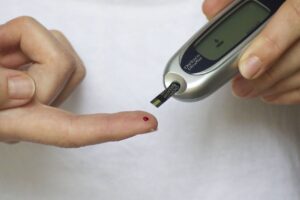Compassion [kuhm–pash-uhn]
noun
A feeling of deep sympathy and sorrow for another who is stricken by misfortune, accompanied by a strong desire to alleviate the suffering.
Compassion Corner is a new weekly series from Patient Worthy that will focus on the subject of compassion in the healthcare and rare disease space. In this series, we explore the role of compassion in this field and what it means for caregivers, patients, and others.

Linda Silvestry, now a 72-year-old great-grandmother, tells her story in the Sansum Clinic blog. Linda credits the compassionate care she received at the Sansum Clinic for the opportunity to lead a rewarding and productive life.
She recalls the early symptoms of type 1 diabetes. She was a fourth-grade student in 1957 and had to adhere to strict rules including taking bathroom breaks only during recess. Linda still has vivid memories of the embarrassment she endured trying to comply with that one rule. It is still uncomfortable to discuss but Linda feels that it will help teachers and parents recognize the disorder early in a child’s life.
She recalls other symptoms such as fatigue, blurred vision, weight loss, an increase in thirst, constant hunger, and frequent urination. They were common symptoms and not recognized as diabetes at the time.
It was not until she fell into a coma and was rushed to the Santa Barbara hospital that the family learned that Linda had type 1 diabetes.
From there she was transferred to the Santa Barbara Cottage Hospital where she remained (as the only pediatric patient) for one month.
About Type 1 Diabetes
The disorder was originally called juvenile diabetes. In type 1 diabetes the pancreas does not produce a sufficient amount of insulin, a hormone that turns glucose (blood sugar) into energy.
If insulin is in short supply, then glucose will build up in the bloodstream resulting in serious complications. The disease is generally diagnosed in young children through young adulthood. The cause of the disorder is believed to be associated with both environmental and genetic factors. Of the total number of diabetics, about 5 to 10 % are diagnosed with type 1 diabetes. Type 1 diabetics are dependent upon insulin injections for survival.
About the Sansum Clinic
The first doctor who treated Linda was Percy Grey, M.D. Dr. Grey worked with Dr. William Sansum, who founded the Sansum clinic in 1921. Dr. Sansum was part of the team that developed artificial insulin and had the distinction of being the first physician in the United States to administer the treatment. Currently, there are approximately 7.4 million people in the U.S. that are dependent on insulin for survival.
Saint Rosanna
Rosanna Petronella, PA-C, according to Linda, has earned the name Saint Rosanna after treating Linda for the past twenty years. Rosanna joined Sansum in 1983 and is a physician assistant and diabetes educator. Linda describes Rosanna as a kind, compassionate, and caring professional who advises Linda about the amount of insulin she needs.
Linda and Rosanna space the appointments three months apart. They include analyzing blood tests. Rosanna also takes readings from Linda’s FreeStyle Libre medical sensor. The sensor is worn on the arm and evaluates glucose concentration in the fluid surrounding cells called interstitial fluid.
In addition to her other talents, Rosanna created a scale for Linda that helps her to calculate the amount of insulin she needs. The calculation is based on metrics from Linda’s medical history and from the Libre sensor.
Watching a diabetic’s glucose levels closely can avoid either hyperglycemia (high blood sugar) or hypoglycemia (significantly low blood sugar). Either symptom can lead to a diabetic coma similar to the one Linda experienced.
Linda’s Life in Retirement
Linda, now retired, was a linotype operator and worked in retail ads at the Santa Barbara News-Press for the past thirty-four years.
Her life now includes daily walks and generally “staying active”. She looks back on a life that has been and still is, dependent on insulin injections for survival. She is grateful to the Sansum Clinic staff for providing a good quality of life.
Long-Acting Insulin and Quick Insulin
Linda takes both long-acting and quick insulin. The long-acting treatment is similar to the levels of insulin found in a healthy person. When a healthy person eats carbohydrates, their body produces extra insulin. In the case of diabetics, this does not occur. Therefore, Linda must give herself extra insulin if she has a meal consisting of carbohydrates.
Caregiver Collaboration
Linda attributes some of Sansum Clinic’s success to the ease with which information is shared among doctors and staff. Medical experts are always available to share the patient’s history and medications. Linda says that she is grateful for the patient summary that she receives after each visit. She is especially grateful for Sansum having saved her life several times. She hopes that people will realize the importance of being able to contact their doctors during an emergency. Their doctors should be familiar with their medical history.





